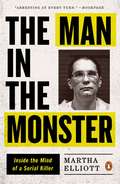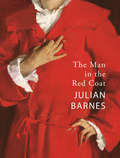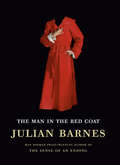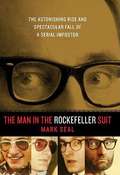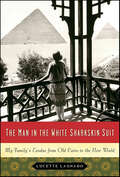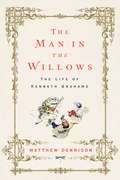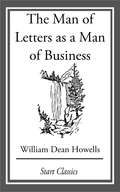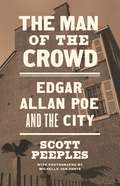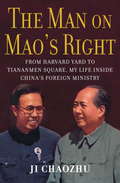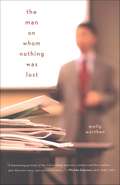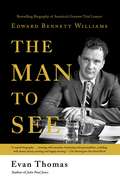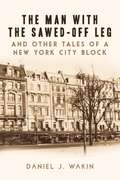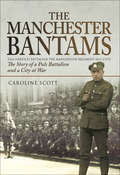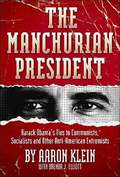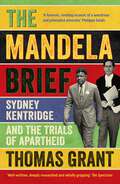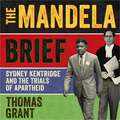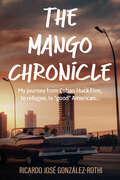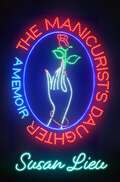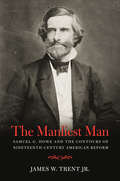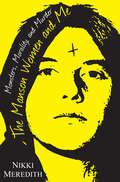- Table View
- List View
The Man in the Monster: An Intimate Portrait of a Serial Killer
by Martha ElliottAn astonishing portrait of a murderer and his complex relationship with a crusading journalist. Michael Ross was a serial killer who raped and murdered eight young women between 1981 and 1984, and several years ago the state of Connecticut put him to death. His crimes were horrific, and he paid the ultimate price for them. When journalist Martha Elliott first heard of Ross, she learned what the world knew of him-- that he had been a master at hiding in plain sight. Elliott, a staunch critic of the death penalty, was drawn to the case when the Connecticut Supreme Court overturned Ross's six death sentences. Rather than fight for his life, Ross requested that he be executed because he didn't want the families of his victims to suffer through a new trial. Elliott was intrigued and sought an interview. The two began a weekly conversation--that developed into an odd form of friendship--that lasted over a decade, until Ross's last moments on earth.Over the course of his twenty years in prison, Ross had come to embrace faith for the first time in his life. He had also undergone extensive medical treatment. The Michael Ross whom Elliott knew seemed to be a different man from the monster who was capable of such heinous crimes. This Michael Ross made it his mission to share his story with Elliott in the hopes that it would save lives. He was her partner in unlocking the mystery of his own evil.In The Man in the Monster, Martha Elliott gives us a groundbreaking look into the life and motivation of a serial killer. Drawing on a decade of conversations and letters between Ross and the author, readers are given an in-depth view of a killer's innermost thoughts and secrets, revealing the human face of a monster--without ignoring the horrors of his crimes. Elliott takes us deep into a world of court hearings, tomblike prisons, lawyers hell-bent to kill or to save--and families ravaged by love and hate. This is the personal story of a journalist who came to know herself in ways she could never have imagined when she opened the notebook for that first interview.
The Man in the Red Coat
by Julian BarnesThe Man Booker Prize-winning author of The Sense of an Ending takes us on a rich, witty, revelatory tour of Belle Époque Paris, via the life story of the pioneering surgeon Samuel Pozzi. IN THE SUMMER OF 1885, three Frenchmen arrived in London for a few days' shopping: a prince, a count and a commoner with an Italian name. In time, each of these men would achieve a certain level of renown, but who were they then and what was the significance of their sojourn to England? Answering these questions, Julian Barnes unfurls the stories of their lives, playing out against the backdrop of the Belle Époque in Paris. Our guide through this world is Samuel Pozzi, the society doctor, free-thinker and man of science with a famously complicated private life, and the subject of one of John Singer Sargent's greatest portraits.In this vivid tapestry of people (Henry James, Sarah Bernhardt, Oscar Wilde, Proust, James Whistler, among many others), place, and time, we see not merely an epoch of glamour and pleasure, but, surprisingly, one of violence, prejudice and nativism--with more parallels to our own age than we might imagine. The Man in the Red Coat is, at once, a fresh portrait of the Belle Époque; an illuminating look at the longstanding exchange of ideas between Britain and France; and a life of a man who lived passionately in the moment but whose ideas and achievements were far ahead of his time.
The Man in the Red Coat
by Julian BarnesFrom the Man Booker Prize-winning author of The Sense of an Ending—a rich, witty, revelatory tour of Belle Époque Paris, via the remarkable life story of the pioneering surgeon, Samuel Pozzi. In the summer of 1885, three Frenchmen arrived in London for a few days' intellectual shopping: a prince, a count, and a commoner with an Italian name. In time, each of these men would achieve a certain level of renown, but who were they then and what was the significance of their sojourn to England? Answering these questions, Julian Barnes unfurls the stories of their lives which play out against the backdrop of the Belle Époque in Paris. Our guide through this world is Samuel Pozzi, the society doctor, free-thinker and man of science with a famously complicated private life who was the subject of one of John Singer Sargent's greatest portraits. In this vivid tapestry of people (Henry James, Sarah Bernhardt, Oscar Wilde, Proust, James Whistler, among many others), place, and time, we see not merely an epoch of glamour and pleasure, but, surprisingly, one of violence, prejudice, and nativism—with more parallels to our own age than we might imagine. The Man in the Red Coat is, at once, a fresh portrait of the Belle Époque; an illuminating look at the longstanding exchange of ideas between Britain and France; and a life of a man who lived passionately in the moment but whose ideas and achievements were far ahead of his time.
The Man in the Rockefeller Suit: The Astonishing Rise and Spectacular Fall of a Serial Impostor
by Mark SealA real-life Talented Mr. Ripley, the unbelievable thirty-year run of a shape-shifting con man. The story of Clark Rockefeller is a stranger-than-fiction twist on the classic American success story of the self-made man-because Clark Rockefeller was totally made up. The career con man who convincingly passed himself off as Rockefeller was born in a small village in Germany. At seventeen, obsessed with getting to America, he flew into the country on dubious student visa documents and his journey of deception began. Over the next thirty years, boldly assuming a series of false identities, he moved up the social ladder through exclusive enclaves on both coasts-culminating in a stunning twelve-year marriage to a rising star businesswoman with a Harvard MBA who believed she'd wed a Rockefeller. The imposter charmed his way into exclusive clubs and financial institutions-working on Wall Street, showing off an extraordinary art collection-until his marriage ended and he was arrested for kidnapping his daughter, which exposed his past of astounding deceptions as well as a connection to the bizarre disappearance of a California couple in the mid-1980s. The story of The Man in the Rockefeller Suit is a probing and cinematic exploration of an audacious imposer-and a man determined to live the American dream by any means necessary.
The Man in the White Sharkskin Suit: My Family's Exodus from Old Cairo to the New World
by Lucette Lagnado“Poignant . . . deeply personal . . . an indelible history of the largely forgotten Jews of Egypt . . . ”—Miami HeraldIn vivid and graceful prose, Lucette Lagnado re-creates the majesty and cosmopolitan glamour of Cairo in the years before Gamal Abdel Nasser’s rise to power. With Nasser’s nationalization of Egyptian industry, her father, Leon, a boulevardier who conducted business in his white sharkskin suit, loses everything, and departs with the family for any land that will take them. The poverty and hardships they encounter in their flight from Cairo to Paris to New York are strikingly juxtaposed against the beauty and comforts of the lives they left behind. An inversion of the American dream set against the stunning portraits of three world cities, Lucette Lagnado’s memoir offers a grand and sweeping story of faith, tradition, tragedy, and triumph.
The Man in the Willows: The Life Of Kenneth Grahame
by Matthew DennisonA moving biography of Kenneth Grahame, author of the children's classic The Wind in the Willows, and of the vision of English pastoral life that inspired it. During his regular days in London, Kenneth Grahame sat behind a mahogany desk as Secretary of the Bank of England; on weekends he retired to the house in the country that he shared with his fanciful wife, Elspeth, and their fragile son, Alistair, and took lengthy walks along the Thames in Berkshire, "tempted by the treasures of hedge and ditch; the rapt surprise of the first lords-and-ladies, the rustle of a field-mouse, the splash of a frog." The result of these pastoral wanderings was his masterful creation of The Wind in the Willows, the enduring classic of children's literature; a cautionary tale for adult readers; a warning of the fragility of the English countryside; and an expression of fear at threatened social changes that, in the aftermath of the World War I, became a reality. Like its remarkable author, the book balances maverick tendencies with conservatism. Kenneth Grahame was an Edwardian pantheist whose work has a timeless appeal, an escapist whose withdrawal from reality took the form of time travel into his own past.
The Man of Letters as a Man of Busine
by William Dean HowellsHe can say that, as the thing is, unless he sells his art he cannot live, that society will leave him to starve if he does not hit its fancy in a picture, or a poem, or a statue; and all this is bitterly true. He is, and he must be, only too glad if there is a market for his wares.
The Man of the Crowd: Edgar Allan Poe and the City
by Scott PeeplesHow four American cities shaped Poe's life and writingsEdgar Allan Poe (1809–1849) changed residences about once a year throughout his life. Driven by a desire for literary success and the pressures of supporting his family, Poe sought work in American magazines, living in the cities that produced them. Scott Peeples chronicles Poe's rootless life in the cities, neighborhoods, and rooms where he lived and worked, exploring how each new place left its enduring mark on the writer and his craft.Poe wrote short stories, poems, journalism, and editorials with urban readers in mind. He witnessed urban slavery up close, living and working within a few blocks of slave jails and auction houses in Richmond and among enslaved workers in Baltimore. In Philadelphia, he saw an expanding city struggling to contain its own violent propensities. At a time when suburbs were just beginning to offer an alternative to crowded city dwellings, he tried living cheaply on the then-rural Upper West Side of Manhattan, and later in what is now the Bronx. Poe's urban mysteries and claustrophobic tales of troubled minds and abused bodies reflect his experiences living among the soldiers, slaves, and immigrants of the American city.Featuring evocative photographs by Michelle Van Parys, The Man of the Crowd challenges the popular conception of Poe as an isolated artist living in a world of his own imagination, detached from his physical surroundings. The Poe who emerges here is a man whose outlook and career were shaped by the cities where he lived, longing for a stable home.
The Man on Mao's Right
by Ji ChaozhuNo other narrative from within the corridors of power has offered as frank and intimate an account of the making of the modern Chinese nation as Ji Chaozhu’sThe Man on Mao’s Right. Having served Chairman Mao Zedong and the Communist leadership for two decades, and having become a key figure in China’s foreign policy, Ji now provides an honest, detailed account of the personalities and events that shaped today’s People’s Republic. The youngest son of a prosperous government official, nine-year-old Ji and his family fled Japanese invaders in the late 1930s, escaping to America. Warmly received by his new country, Ji returned its embrace as he came of age in New York’s East Village and then attended Harvard University. But in 1950, after years of enjoying a life of relative ease while his countrymen suffered through war and civil strife, Ji felt driven by patriotism to volunteer to serve China in its conflict with his adoptive country in the Korean War. Ji’s mastery of the English language and American culture launched his improbable career, eventually winning him the role of English interpreter for China’s two top leaders: Premier Zhou Enlai and Party Chairman Mao Zedong. With a unique blend of Chinese insight and American candor, Ji paints insightful portraits of the architects of modern China: the urbane, practical, and avuncular Zhou, the conscience of the People’s Republic; and the messianic, charismatic Mao, student of China’s ancient past–his country’s stern father figure. In Ji’s memoir, he is an eyewitness to modern Chinese history, including the Great Leap Forward, the Cultural Revolution, the Nixon summit, and numerous momentous events in Tiananmen Square. As he becomes caught up in political squabbles among radical factions, Ji’s past and charges against him of “incorrect” thinking subject him to scrutiny and suspicion. He is repeatedly sent to a collective farm to be “reeducated” by the peasants. After the Mao years, Ji moves on to hold top diplomatic posts in the United States and the United Kingdom and then serves as under secretary-general of the United Nations. Today, he says, “The Chinese know America better than the Americans know China. The risk is that we misperceive each other. ” This highly accessible insider’s chronicle of a struggling people within a developing powerhouse nation is also Ji Chaozhu’s dramatic personal story, certain to fascinate and enlighten Western readers. A riveting biography and unique historical record,The Man on Mao’s Rightrecounts the heartfelt struggle of a man who loved two powerful nations that were at odds with each other. Ji Chaozhu played an important role in paving the way for what is destined to be known as the Chinese Century. Praise forThe Man on Mao’s Right "Brave, beautifully written testimony . A true "fly-on-the-wall" account of the momentous changes in Chinese society and international relations over the last century. " --Kirkus Reviews “It is a relief to read an account by an urbane and often witty insider who neither idolizes nor demonizes China's top leaders . . . . Highly recommended. "—Library Journal, starred review
The Man on Whom Nothing Was Lost: The Grand Strategy of Charles Hill
by Molly WorthenPsychologically astute and passionately written, Molly Worthen’s remarkable debut charts the intricate relationship between student and teacher, biographer and subject. As a Yale freshman, Worthen found herself deeply fascinated by worldly-wise professor Charles Hill, a former diplomat who had shaped American foreign policy in his forty-year career as an adviser to Henry Kissinger, George Shultz, and Boutros Boutros-Ghali, among others. Hill was never afraid to tell students how to think or what to do, and the Grand Strategy seminar he co-taught had developed a cult following.The Man on Whom Nothing Was Lost is at once the biography of a political insider and the story of how its author evolved as she wrote it. In a moving, highly original work, Worthen conveys the joy and the heartache of uncovering the human being behind one’s idol.
The Man to See
by Evan ThomasThis bestselling biography of legendary trial lawyer Edward Bennett Williams is "a skillful and lively portrait of a larger-than-life lawyer" (Kirkus Reviews).Legendary attorney Edward Bennet Williams was arguably the best trial lawyer ever to practice. Now, for the first time, bestselling author Evan Thomas takes us into the courtrooms of Williams's greatest performances as he defends "Godfather" Frank Costello, Jimmy Hoffa, Frank Sinatra, The Washington Post, and others, as well as behind the scenes where the witnesses are coached, the traps set, and the deals cut. In addition to being a lawyer of unprecedented influence, Williams was also an important Washington insider, privy to the secrets of America's most powerful men. Thomas tells the truth behind the stories that made Williams one of the most talked about public figures of his time, including Williams's role in the publication of the Pentagon Papers and the possibility that Williams may have been Watergate's Deep Throat. Based on Thomas's exclusive access to Williams's papers, The Man to See is an unprecedented look at the strategies and influence of this exceptional man.
The Man with the Sawed-Off Leg and Other Tales of a New York City Block
by Daniel J. WakinThey stand proudly gazing across the Hudson River at the cliffs of New Jersey. Their brows are marked by ornamental pediments. Greek columns stand as sentries by their entrances and stone medallions bedeck their chests. They are seven graceful relics of Beaux Arts New York, townhouses built more than 100 years ago for a new class of industrialists, actors and scientists -- many from abroad -- who made their fortunes in the United States and shaped the lives of Americans.This book brings to life the ghosts who inhabit that row of townhouses on Manhattan’s stately Riverside Drive for the first fifty years of the 20th Century, including a vicious crew of hoodlums who carried out what at the time was the largest armored car robbery in American history. It was a daring, minutely planned exploit that ended in blood, when one of the gangsters accidentally shot himself. He was taken to one of the townhouses -- then, in 1934, an underworld safehouse -- where he died and was stuffed in a steamer trunk (but his cohorts had to saw off one of his legs to fit him in it). From gangsters to industrialists, from future mayors to murderers, from movie stars to mafia dons, one block in a burgeoning city saw it all. The people who lived in each of the "Seven Sisters" reads like a mini Who's Who. Meet: * Percy Geary and John Oley, two Albany gangsters with a background in kidnapping and bootlegging; * Lucretia Davis, baking powder heiress whose parents were engaged in a bitter divorce that included allegations that her mother was trying get her father declared insane and take over his business; * Jokichi Takamine, the world's first biotech engineer and a rare Japanese scientist in the United States at the turn of the 19th century--He discovered diastase, an enzyme to ferment whisky and settle the stomach, and the adrenaline, a major scientific discovery; * Marion Davies, the mistress of William Randolph Hearst, who rose to movie stardom on the back of W.R.'s publicity machine while living on the block; * Julia Marlowe, American's greatest Shakespearean actress around 1900, just to name a few. If only the buildings could speak. * The Fabers of pencil fame * Billy Phelan's Greatest Game (Albany gang made famous by William Kennedy) * Duke Ellington, two mayors, and lurking in the background Legs Diamond.... If only the walls could talk? Dan Wakins makes it so in this unforgettable intimate glimpse into the history of New York City.
The Manchester Bantams: The Story of a Pals Battalion and a City at War - 23rd (Service) Battalion the Manchester Regiment (8th City)
by Caroline ScottIn May 1916 Major Eustace Lockhart Maxwell, a former Indian cavalry officer, was given command of an infantry battalion in France. After 48 hours with his new unit, Maxwell wrote to his family: The outstanding characteristic of those who belong to it seems to be their extraordinary self-complacency! Esprit de corps is a fine thing, but the satisfaction with which they regard themselves, their battalion, its internal economy, its gallantry, its discipline, its everything else, is almost indecent! If at the end of a month my opinion of them is half as good as their own, I shall think myself uncommonly lucky. This was the 23rd Manchester Bantam Battalion, a unit entirely composed of men of a height between 5ft and 5ft 3, and its esprit de corps was about to be severely tested. The Bantams left colorful, characterful, moving and often amusing records of their experiences. Using a wealth of previously unpublished sources, this book follows the Manchester men through their training, their experiences of the Somme and the Third Ypres Campaign, to Houthulst Forest where, in October 1917, the Battalion was practically annihilated.
The Manchurian President: Barack Obama's Ties to Communists, Socialists and Other Anti-American Extremists
by Aaron KleinThe book uncovers a far-leftist, anti-American nexus that has been instrumental in not only helping build Obama's political career but in securing his presidency. Klein details with shocking precision how this nexus continues to influence Obama and the White House and is involved in drafting policy aimed at reshaping our country. Highlights of the book: Obama's mysterious college years unearthed, shocking details of Obama's relationship with Bill Ayers and other Weathermen terrorists, Obama's ties to Islam and black liberation theology, startling facts about Obama's eligibility to serve as president, Obama's membership in a socialist party probed.
The Mandela Brief: Sydney Kentridge and the Trials of Apartheid
by Thomas Grant'Kentridge is one of many lawyers to whom I will forever be in debt, and whose everyday fights against injustice should inspire us all' David LammySydney Kentridge carved out a reputation as South Africa's most prominent anti-apartheid advocate - his story is entwined with the country's emergence from racial injustice and oppression. He is the only advocate to have acted for three winners of the Nobel Peace Prize - Nelson Mandela, Archbishop Desmond Tutu and Chief Albert Lutuli. Already world-famous for his landmark cases including the Treason Trial of Nelson Mandela and the other leading members of the ANC, the inquiry into the Sharpeville massacre, and the inquest into the death of Steve Biko, he then became England's premier advocate.Through the great set-pieces of the legal struggle against apartheid - cases which made the headlines not just in South Africa, but across the world - this biography is a portrait of enduring moral stature.
The Mandela Brief: Sydney Kentridge and the Trials of Apartheid
by Thomas GrantThe remarkable story of Sir Sydney Kentridge QC, the greatest living barrister.Sydney Kentridge carved out a reputation as South Africa's most prominent anti-apartheid advocate - his story is entwined with the country's emergence from racial injustice and oppression. He is the only lawyer to have acted for three winners of the Nobel Peace Prize - Nelson Mandela, Archbishop Desmond Tutu and Chief Albert Lutuli. Already world-famous for his landmark cases including the Treason Trial of Nelson Mandela and the other leading members of the ANC, the inquiry into the Sharpeville massacre, and the inquest into the death of Steve Biko, he then became England's premier advocate.Through the great set-pieces of the legal struggle against apartheid - cases which made the headlines not just in South Africa, but across the world - this biography is a portrait of enduring moral stature.(P) 2022 Hodder & Stoughton Limited
The Mandela Brief: Sydney Kentridge and the Trials of Apartheid
by Thomas Grant'A forensic, riveting account of a wondrous and principled advocate' Philippe Sands'Well-written, deeply researched and wholly gripping' The Spectator'Meticulously researched' The Times'Kentridge is one of many lawyers to whom I will forever be in debt, and whose everyday fights against injustice should inspire us all' David LammySydney Kentridge carved out a reputation as South Africa's most prominent anti-apartheid advocate - his story is entwined with the country's emergence from racial injustice and oppression. He is the only advocate to have acted for three winners of the Nobel Peace Prize - Nelson Mandela, Archbishop Desmond Tutu and Chief Albert Lutuli. Already world-famous for his landmark cases including the Treason Trial of Nelson Mandela and the other leading members of the ANC, the inquiry into the Sharpeville massacre, and the inquest into the death of Steve Biko, he then became England's premier advocate.Through the great set-pieces of the legal struggle against apartheid - cases which made the headlines not just in South Africa, but across the world - this biography is a portrait of enduring moral stature.
The Mango Chronicle
by Ricardo José González-RothiIn an entangled exodus to freedom during a nuclear missile crisis, a young boy' s Cuban Huck-Finn-childhood is upended. After a decades-long struggle with identity, he transitions from refugee to “ good” American, returning to his roots for redemption. He left his birthplace during a nuclear missile crisis. As a refugee in a foreign land he struggles to adjust to a new set of life circumstances. The author recollects his childhood in his Cuban barrio from the eyes of a child, and then decades later, from the vantage of a grown adult. From stealing a rowboat and being nearly capsized by a Russian tanker, to befriending an old fisherman who tells him a haunting tale, to being bullied by a neighborhood thug, to cockfights gone wrong, to witnessing the plight of political prisoners during an invasion, to dealing with the injustices of growing up in a machismo and homophobic culture, he led a Cuban Huck Finn childhood. Arriving in a foreign land which is at times unwelcoming, he struggles to assimilate while preserving his native soul. Eventually he finds redemption upon circling back to his roots when he returns to the island.
The Mango Tree: A Memoir of Fruit, Florida, and Felony
by Annabelle TometichEater's Best Food Books to Read This Spring This &“witty, humorous, and heartfelt&“ (Cinelle Barnes) memoir navigates the tangled branches of Annabelle Tometich&’s life, from growing up in Florida as the child of a Filipino mother and a deceased white father to her adult life as a med-school-reject-turned-food-critic. When journalist Annabelle Tometich picks up the phone one June morning, she isn&’t expecting a collect call from an inmate at the Lee County Jail. And when she accepts, she certainly isn&’t prepared to hear her mother&’s voice on the other end of the line. However, explaining the situation to her younger siblings afterwards was easy; all she had to say was, &“Mom shot at some guy. He was messing with her mangoes.&” They immediately understood. Answering the questions of the breaking-news reporter—at the same newspaper where Annabelle worked as a restaurant critic––proved more difficult. Annabelle decided to go with a variation of the truth: it was complicated. So begins The Mango Tree, a poignant and deceptively entertaining memoir of growing up as a mixed-race Filipina &“nobody&” in suburban Florida as Annabelle traces the roots of her upbringing—all the while reckoning with her erratic father&’s untimely death in a Fort Myers motel, her fiery mother&’s bitter yearning for the country she left behind, and her own journey in the pursuit of belonging. With clear-eyed compassion and piercing honesty, The Mango Tree is a family saga that navigates the tangled branches of Annabelle&’s life, from her childhood days in an overflowing house flooded by balikbayan boxes, vegetation, and juicy mangoes, to her winding path from medical school hopeful to restaurant critic. It is a love letter to her fellow Filipino Americans, her lost younger self, and the beloved fruit tree at the heart of her family. But above all, it is an ode to Annabelle&’s hot-blooded, whip-smart mother Josefina, a woman who made a life and a home of her own, and without whom Annabelle would not have herself.
The Mangrove Tree: Planting Trees to Feed Families
by Susan L. Roth Cindy TrumboreThe fascinating story of Dr. Gordon Sato, who helped a small African village become self-sustaining by planting a forest of mangrove trees to reshape the community's ecosystem.For a long time, the people of Hargigo, a village in the tiny African country of Eritrea, were living without enough food for themselves and their animals. The families were hungry, and their goats and sheep were hungry too. Then along came a scientist, Dr. Gordon Sato, who helped change their lives for the better. And it all started with some special trees. These are the trees, Mangrove trees, That were planted by the sea. With alternating verse and prose passages, The Mangrove Tree invites readers to discover how Dr. Sato's mangrove tree-planting project transformed an impoverished village into a self-sufficient community. This fascinating story is a celebration of creativity, hard work-and all those mangrove trees that were planted by the sea!
The Manicurist's Daughter: A Memoir
by Susan LieuAn emotionally raw memoir about the crumbling of the American Dream and a daughter of refugees who searches for answers after her mother dies during plastic surgery.Susan Lieu has long been searching for answers. About her family’s past and about her own future. Refugees from the Vietnam War, Susan’s family escaped to California in the 1980s after five failed attempts. Upon arrival, Susan’s mother was their savvy, charismatic North Star, setting up two successful nail salons and orchestrating every success—until Susan was eleven. That year, her mother died from a botched tummy tuck. After the funeral, no one was ever allowed to talk about her or what had happened.For the next twenty years, Susan navigated a series of cascading questions alone—why did the most perfect person in her life want to change her body? Why would no one tell her about her mother’s life in Vietnam? And how did this surgeon, who preyed on Vietnamese immigrants, go on operating after her mother’s death? Sifting through depositions, tracking down the surgeon’s family, and enlisting the help of spirit channelers, Susan uncovers the painful truth of her mother, herself, and the impossible ideal of beauty.The Manicurist’s Daughter is much more than a memoir about grief, trauma, and body image. It is a story of fierce determination, strength in shared culture, and finding your place in the world.
The Manliest Man: Samuel G. Howe and the Contours of Nineteenth-Century American Reform
by James W. TrentA native of Boston and a physician by training, Samuel G. Howe (1801-1876) led a remarkable life. He was a veteran of the Greek War of Independence, a fervent abolitionist, and the founder of both the Perkins School for the Blind and the Massachusetts School for Idiotic and Feeble-Minded Children. Married to Julia Ward Howe, author of "Battle Hymn of the Republic," he counted among his friends Senator Charles Sumner, public school advocate Horace Mann, and poet Henry Wadsworth Longfellow. Always quick to refer to himself as a liberal, Howe embodied the American Renaissance's faith in the perfectibility of human beings, and he spoke out in favor of progressive services for disabled Americans. A Romantic figure even in his own day, he embraced a notion of manliness that included heroism under fire but also compassion for the underdog and the oppressed. Though hardly a man without flaws and failures, he nevertheless represented the optimism that characterized much of antebellum American reform. The first full-length biography of Samuel G. Howe in more than fifty years, The Manliest Man explores his life through private letters and personal and public documents. It offers an original view of the reformer's personal life, his association with social causes of his time, and his efforts to shape those causes in ways that allowed for the greater inclusion of devalued people in the mainstream of American life.
The Mannings: The Fall and Rise of a Football Family
by Lars AndersonFrom New York Times bestselling author Lars Anderson comes a revealing portrait of the first family of American sports. What the Kennedys are to politics, the Mannings are to football. Two generations have produced three NFL superstars: Archie Manning, the Ole Miss hero-turned-New Orleans Saint; his son Peyton, widely considered one of the greatest quarterbacks ever to play the game; and Peyton's younger brother, Eli, who won two Super Bowl rings of his own. And the oldest Manning child, Cooper--who was forced to quit playing sports after he was diagnosed at age eighteen with a rare spinal condition--might have been the most talented of them all. In The Mannings, longtime Sports Illustrated writer Lars Anderson gives us, for the first time, the never-before-told story of this singular athletic dynasty--a story that shows us how finding strength in the face of catastrophe can be the key to success on and off the playing field. Growing up, the three Manning brothers dream of playing side by side on the gridiron at Ole Miss. But with Cooper forced to the bench before his prime, Peyton must fight to win glory for them both. Meanwhile, Eli is challenged by his college coach to stop trailing in the footsteps of others and forge his own path. With Archie's achievements looming over them, the brothers begin the climb to football history. From the Manning family backyard to the bright lights of Super Bowl 50, The Mannings is an epic, inspiring saga of a family of tenacious competitors who have transfixed a nation.
The Manson Women and Me: Monsters, Morality, And Murder
by Nikki MeredithIn the summer of 1969, Leslie Van Houten and Patricia Krenwinkel carried out horrific acts of butchery on the orders of the charismatic cult leader Charles Manson. At their murder trial the following year, lead prosecutor Vincent Bugliosi described the two so-called Manson Women as “human monsters.” But to anyone who knew them growing up, they were bright, promising girls, seemingly incapable of such an unfathomable crime.Award-winning journalist Nikki Meredith began visiting Van Houten and Krenwinkel in prison to discover how they had changed during their incarceration. The more Meredith got to know them, the more she was lured into a deeper dilemma: What compels “normal” people to do unspeakable things?The author’s relationship with her subjects provides a chilling lens through which we gain insight into a particular kind of woman capable of a particular kind of brutality. Through their stories, Nikki Meredith takes readers on a dark journey into the very heart of evil.
